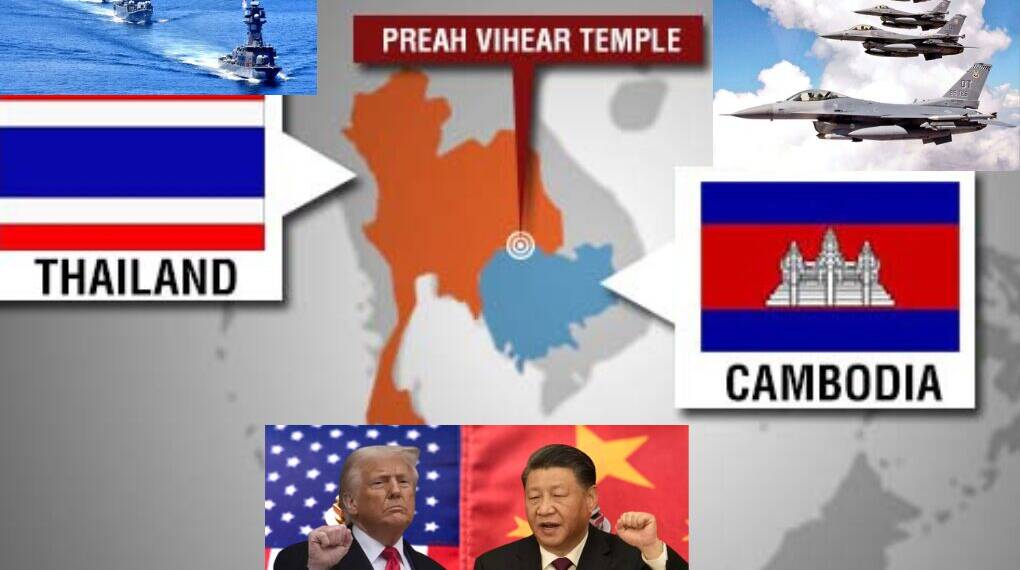On July 24, 2025, a long-simmering border dispute between Thailand and Cambodia exploded into deadly violence, killing at least 11 civilians and displacing thousands. At first glance, the fighting — centered near the centuries-old Preah Vihear Temple — appears to be a continuation of historical grievances between two Southeast Asian neighbors. But beneath the surface lies a far more dangerous dynamic: the growing involvement of the United States and China, turning the conflict into a potential proxy war with global implications.
Ancient Dispute, Modern Battlefield
The dispute over the Preah Vihear Temple and its surrounding territory dates back more than a century. In 1907, a map drawn by French colonial administrators placed the temple within Cambodian territory, a designation that Thailand later rejected. In 1962, the International Court of Justice (ICJ) awarded the temple to Cambodia — a ruling reaffirmed in 2013. However, disagreements over adjacent lands remain unresolved and continue to stir nationalist passions on both sides.
Tensions have flared periodically, most notably between 2008 and 2011, when clashes left around 40 dead. The most recent spike in violence began in May 2025, when a skirmish in the Emerald Triangle killed a Cambodian soldier. Since then, both sides have ramped up military activity.
On July 16 and again on July 23, landmine explosions injured Thai soldiers, prompting the Thai Air Force to launch F-16 airstrikes on Cambodian targets near Preah Vihear and Ta Muen Thom. Cambodia responded with BM-21 Grad rocket fire, accusing Thailand of “brutal aggression.”
U.S. and China Step In
What makes this latest round of conflict especially concerning is the foreign involvement. Multiple reports confirm that the United States has authorized Thailand to use American-supplied F-16s in operations against Cambodian militias, which Thailand alleges are being backed by China.
In response, China is reportedly preparing to transfer advanced JF-17 and J-10C fighter jets to Cambodia — a military boost that could drastically shift the balance of power. These developments are drawing parallels to other global proxy wars, like the Ukraine conflict, where outside powers arm opposing sides to advance their strategic interests.
Thailand remains a U.S. treaty ally, hosting critical military infrastructure and participating in joint exercises like Cobra Gold. Cambodia, on the other hand, has become a key Chinese partner, heavily reliant on Beijing for infrastructure financing, arms, and diplomatic support. Cambodia is also central to China’s Belt and Road Initiative (BRI) in Southeast Asia.
A Flashpoint in the Indo-Pacific
The border conflict is no longer confined to two nations. It’s evolving into a flashpoint in the Indo-Pacific rivalry between Washington and Beijing.
The potential delivery of Chinese fighter jets to Cambodia is being viewed by analysts as a strategic countermove to the U.S. presence in Thailand. Meanwhile, Beijing’s offer to mediate — under the banner of neutrality — is being interpreted as an attempt to gain diplomatic leverage while protecting its interests.
This contest of influence comes amid growing friction in the broader region, particularly in the South China Sea, where U.S. freedom-of-navigation operations and Chinese militarization continue to stoke tensions. A militarized standoff between Thai and Cambodian forces, with superpower backing, could risk a spillover into maritime domains critical for global trade and energy.
Political Fallout at Home
The border crisis is also shaking domestic politics in both Thailand and Cambodia.
In Thailand, Prime Minister Paetongtarn Shinawatra was suspended on July 1 after a leaked phone conversation with former Cambodian Prime Minister Hun Sen revealed internal divisions and disagreements with the military. Nationalists have accused her of being too soft on Cambodia, weakening her Pheu Thai Party.
In Cambodia, Prime Minister Hun Manet has seized the moment to consolidate power. Framing Thailand’s airstrikes as “aggression,” he has rallied domestic support and clamped down on Thai imports and media. His assertive stance may boost his popularity but risks further escalation.
A Border with No Resolution
At the heart of the conflict is a failure to finalize border demarcation. The Joint Boundary Commission has made little progress in recent years, and both sides continue to interpret the ICJ’s rulings to suit their national narratives.
Thailand’s refusal to accept ICJ jurisdiction over disputed buffer zones has made peaceful resolution more difficult. For Cambodians, the court’s rulings affirm sovereignty. For many Thai nationalists, the Preah Vihear Temple remains a symbol of lost territory and national pride.
This combination of legal ambiguity, historical grievance, and nationalist politics makes the border region perpetually vulnerable to conflict.
Risk of Broader Escalation
With advanced weaponry, escalating rhetoric, and foreign involvement, the risk of wider conflict is growing.
Satellite images and social media posts indicate heavy fighting across six border zones, with reports of drones, artillery exchanges, and mobilization of ground troops. The possibility of miscalculation or an accidental clash involving U.S. or Chinese personnel in the region adds a dangerous layer of complexity.
The South China Sea, already tense due to overlapping maritime claims, could become even more volatile if the Thailand-Cambodia conflict draws in naval forces or triggers a show of force by either superpower.
The Path Forward
Both the U.S. and China have issued calls for de-escalation, but their actions — supplying jets and strategic support — suggest neither side is ready to disengage. For the region, and particularly ASEAN, the challenge is to prevent a local conflict from becoming a geopolitical crisis.
Diplomatic initiatives are urgently needed, but mediation will require trust — something in short supply between the parties involved. Whether through ASEAN frameworks, UN intervention, or quiet backchannel talks, the alternative is bleak: continued escalation in a region already riddled with strategic rivalries.
What began as a border clash rooted in colonial-era grievances has morphed into something much bigger — a proxy showdown between global giants. The Thailand-Cambodia conflict now sits at the intersection of nationalism, history, and superpower rivalry.
As advanced weaponry pours in and regional tensions mount, the world is left asking: will diplomacy prevail — or will Southeast Asia become the next theater in the global struggle for dominance?








